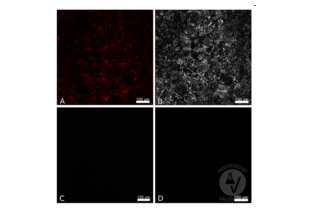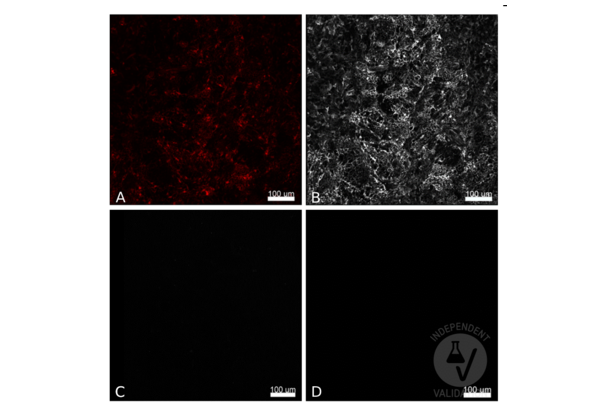RFP Anticorps
- Cellular Localization and Protein Trafficking: Researchers can fuse the RFP protein to their protein of interest. By using an RFP antibody, they can detect the presence and subcellular localization of the fusion protein within cells. This helps in understanding the dynamics and movement of proteins within cellular compartments.
- Gene Expression Studies: RFP can also be used as a marker for gene expression. Researchers can use RFP-tagged constructs to monitor the expression of specific genes. Antibodies against RFP are then used to detect the RFP-tagged protein produced from these genes.
- Protein Interaction Studies: RFP can be used in protein-protein interaction studies. Proteins of interest are tagged with RFP and their interactions with other proteins are investigated. Antibodies against RFP can then be used to detect these interactions either through immunoprecipitation or other methods.
- Live Cell Imaging: RFP-tagged proteins can be imaged in real-time within live cells using fluorescence microscopy. This allows researchers to track protein dynamics, localization changes, and cellular responses in real-time.
- Flow Cytometry: Antibodies against RFP can be used in flow cytometry (FACS) to quantify the expression levels of RFP-tagged proteins in a population of cells. This is particularly useful for high-throughput studies.
- High-Content Screening: RFP antibodies can be used in high-content screening assays to study various cellular processes and responses across large sets of conditions or compounds.
- Visualization of Cellular Structures: RFP can be fused to specific cellular structures such as organelles, cytoskeletal components, or membranes. Antibodies against RFP allow researchers to visualize these structures and their dynamics.
- Co-localization Studies: Antibodies against RFP can be used in combination with antibodies against other fluorescent proteins to study co-localization and potential interactions between different cellular components.

 RFP anticorps (ABIN129578)
RFP anticorps (ABIN129578)
RFP Reactivité: Discosoma WB, ELISA, IF, IP, IHC, FACS, IHC (fro), IHC (p) Hôte: Lapin Polyclonal unconjugated
RFP Reactivité: Discosoma WB, ELISA Hôte: Souris Monoclonal 8E5-G7 unconjugated
RFP Anticorps par Réactivité
Trouvez RFP Anticorps pour une variété d'espèces telles que anti-Discosoma RFP. Les espèces listées ci-dessous sont parmi celles disponibles. Cliquez sur un lien pour accéder aux produits correspondants.
RFP Anticorps par Application
Trouver RFP Anticorps validé pour une application spécifique telle que WB, IF, ELISA, ICC. Certaines des applications disponibles sont énumérées ci-dessous. Cliquez sur un lien pour accéder aux produits correspondants
RFP Anticorps par Hote
On trouve ici des RFP Anticorps avec un Hote spécifique. Les Hote mentionnés ici sont quelques-uns de ceux qui sont disponibles. Un clic sur le lien correspondant permet d'accéder aux produits
RFP Anticorps par Epitope
Trouver RFP Anticorps avec un épitope spécifique. Les épitopes listés ci-dessous sont parmi ceux disponibles. Cliquez sur un lien pour accéder aux produits correspondants.
RFP Anticorps par Clonalité
Trouvez les RFP Anticorps monoclonaux ou polyclonaux disponibles. Cliquez sur un lien pour accéder aux produits correspondants.
RFP Anticorps par Fragment
On trouve ici des RFP Anticorps avec un Fragment spécifique. Les Fragment mentionnés ici sont quelques-uns de ceux qui sont disponibles. Un clic sur le lien correspondant permet d'accéder aux produits
RFP Anticorps fréquemment utilisés
- (356)
- (11)
- (1)
- (16)
- (9)
- (27)
- (3)
- (2)
- (4)
- (1)
- (1)
- (1)
- (4)
- (2)
- (1)
- (2)
- (2)
- (1)
- (1)
- (2)
- (2)
- (1)
- (1)
- (1)
- (1)
Dernières publications pour nos RFP Anticorps
: "Injury primes mutation-bearing astrocytes for dedifferentiation in later life." dans: Current biology : CB, (2023) (PubMed).: "Diet suppresses glioblastoma initiation in mice by maintaining quiescence of mutation-bearing neural stem cells." dans: Developmental cell, (2023) (PubMed).
: "Molecular sensing of mechano- and ligand-dependent adhesion GPCR dissociation." dans: Nature, Vol. 615, Issue 7954, pp. 945-953, (2023) (PubMed).
: "Overexpression of Lin28A in neural progenitor cells in vivo does not lead to brain tumor formation but results in reduced spine density." dans: Acta neuropathologica communications, Vol. 9, Issue 1, pp. 185, (2022) (PubMed).
: "A versatile viral toolkit for functional discovery in the nervous system. ..." dans: Cell reports methods, Vol. 2, Issue 6, pp. 100225, (2022) (PubMed).
: "Axon guidance at the spinal cord midline-A live imaging perspective." dans: The Journal of comparative neurology, (2021) (PubMed).
: "Gene regulatory networks controlling differentiation, survival, and diversification of hypothalamic Lhx6-expressing GABAergic neurons." dans: Communications biology, Vol. 4, Issue 1, pp. 95, (2021) (PubMed).
: "Extrinsic Regulators of mRNA Translation in Developing Brain: Story of WNTs." dans: Cells, Vol. 10, Issue 2, (2021) (PubMed).
: "Co-activation of Sonic hedgehog and Wnt signaling in murine retinal precursor cells drives ocular lesions with features of intraocular medulloepithelioma." dans: Oncogenesis, Vol. 10, Issue 11, pp. 78, (2021) (PubMed).
: "The white matter is a pro-differentiative niche for glioblastoma." dans: Nature communications, Vol. 12, Issue 1, pp. 2184, (2021) (PubMed).
Avez-vous cherché autre chose?
- RFFL Anticorps
- RFC5 Anticorps
- RFC4 Anticorps
- RFC3 Anticorps
- RFC2 Anticorps
- RFC1 Anticorps
- REXO4 Anticorps
- REXO2 Anticorps
- REXO1 Anticorps
- REV3L Anticorps
- REV1 Anticorps
- RETNLB Anticorps
- Retinol-Binding Protein Anticorps
- Retinol Dehydrogenase 5 (11-Cis/9-Cis) Anticorps
- Retinol Dehydrogenase 14 (All-Trans/9-Cis/11-Cis) Anticorps
- Retinol Binding Protein 5 Anticorps
- Retinol Binding Protein 2, Cellular Anticorps
- Retinol Binding Protein 1, Cellular Anticorps
- Retinoid X Receptor, gamma Anticorps
- Retinoid X Receptor, alpha Anticorps
- RFT1 Anticorps
- RFTN1 Anticorps
- RFWD2 Anticorps
- RFWD3 Anticorps
- RFX1 Anticorps
- RFX2 Anticorps
- RFX3 Anticorps
- RFX4 Anticorps
- RFX5 Anticorps
- RFX6 Anticorps
- RFX7 Anticorps
- RFX8 Anticorps
- RFXANK Anticorps
- RFXAP Anticorps
- RG9MTD1 Anticorps
- RG9MTD2 Anticorps
- RG9MTD3 Anticorps
- RGC32 Anticorps
- RGL1 Anticorps
- RGL2 Anticorps




